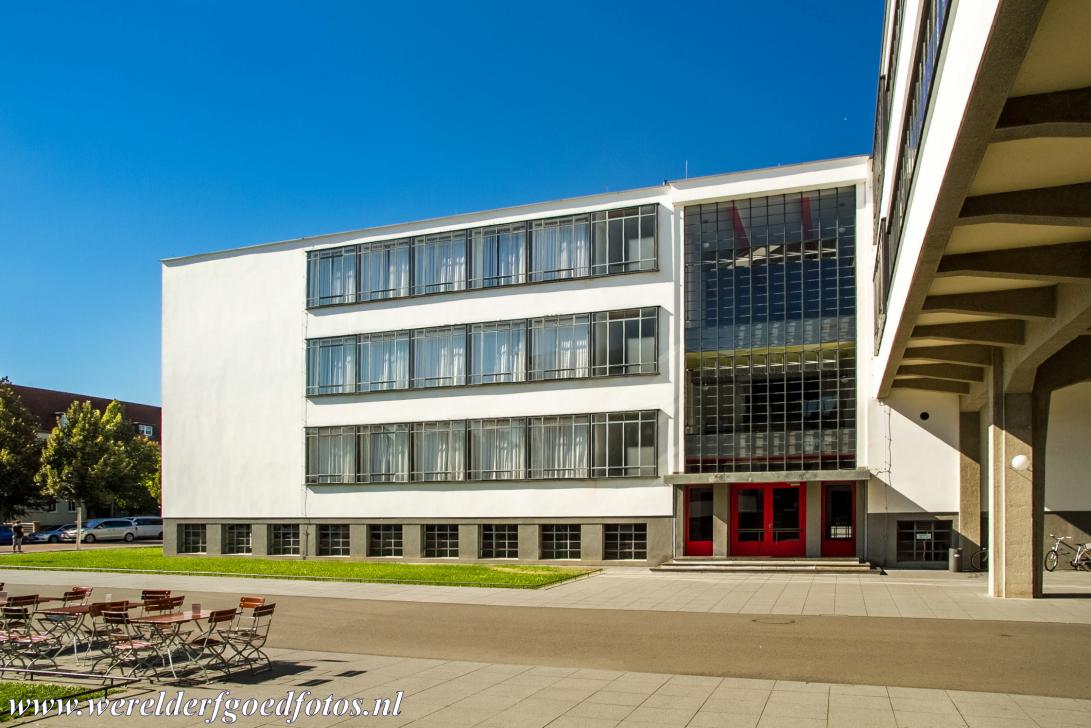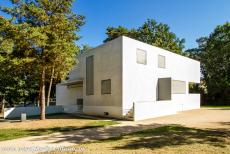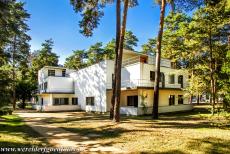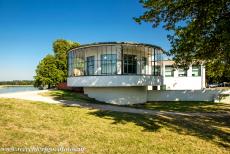Bauhaus and its Sites in Dessau: The Staatliches Bauhaus is commonly known simply as the Bauhaus, it was the most influential modernist art school in the beginning of the 20th century. The Bauhaus school existed in three cities in Germany: Weimar, Dessau and Berlin. In 1919, the Bauhaus was founded in Weimar by the architect Walter Gropius. In 1925, when further work in Weimar became impossible, the Bauhaus moved to Dessau. Dessau provided money for the new school building, Walter Gropius designed the new school complex. In his design, Gropius refined architectonic ideas he first put into practice in the construction of the Fagus Factory in Alfeld. In Dessau, Walter Gropius also constructed a detached house for the school director and three semi-detached houses for the Bauhaus masters. When national socialists took over the local government in Dessau in 1932, the Bauhaus was forced to move to Berlin. In 1933, the school was closed under pressure from the nazi regime. The architect-directors Walter Gropius, Hannes Meyer and Ludwig Mies van der Rohe are most closely associated with the Bauhaus. In the early years of the 20th century, the Bauhaus created a revolution in architecture, art and design. The Bauhaus architecture became one of the most important influential currents in the Modern Movement. The buildings of Zollverein in Essen were built in the Bauhaus style. The famous Dutch art movement De Stijl (The Style) greatly influenced the Bauhaus. The Bauhaus locations in Dessau are part of the World Heritage: Bauhaus and its Sites in Weimar and Dessau. Bauhaus and its Sites in Weimar and Dessau were declared a UNESCO World Heritage in 1996. World Heritage Art: Bauhaus Revisited and Ode to the Bauhaus
www.werelderfgoedfotos.nl © Copyright World Heritage Photos

Bauhaus and its Sites in Weimar and Dessau: The Bauhaus building in Dessau was designed by Walter Gropius to house the Bauhaus school. The Bauhaus was founded in the town of Weimer in 1919 by the German architect Walter Gropius. The Bauhaus was based on the unification of architecture, art and craft. The Bauhaus embraced the idea of a Gesamtkunstwerk, a total work of art. For political reasons, the Bauhaus moved from Weimar to Dessau in 1925.

Bauhaus and its Sites in Weimar and Dessau: The Bauhaus building in Dessau was designed by Walter Gropius to house the Bauhaus school. The Bauhaus was founded in the town of Weimer in 1919 by the German architect Walter Gropius. The Bauhaus was based on the unification of architecture, art and craft. The Bauhaus embraced the idea of a Gesamtkunstwerk, a total work of art. For political reasons, the Bauhaus moved from Weimar to Dessau in 1925.

The Bauhaus and its Sites in Dessau: The Bauhaus building in Dessau. Walter Gropius designed the buildings for the new school in Dessau in 1925-1926, the building contained many features that later became a trademark of modern architecture, such as an asymmetrical pinwheel-plan, a steel-frame construction and glass façades. The Bauhaus existed in three cities in Germany: Weimar, Dessau and Berlin.

Bauhaus and its Sites in Dessau: The school building designed by Walter Gropius. The Bauhaus building became one of the most important icons of Modernism in the 20th century. The school building has three wings connected by bridges. The building was damaged during World War II. The Bauhaus building was declared a historic monument in 1964, it was restored in 1975 and 1976. Bauhaus and its Sites in Weimar and Dessau became a UNESCO World Heritage in 1996.

Bauhaus and its Sites in Dessau: The Cafe-Bistro im Bauhaus, situated in the Bauhaus building. The city of Dessau provided money for a new school building. In 1932, when national socialists took over the local government in Dessau, the Bauhaus School was forced to move to Berlin. In 1933, the Bauhaus was closed under pressure from the nazi regime. The Staatliches Bauhaus is commonly known as Das Bauhaus, the Bauhaus.

Bauhaus and its Sites in Dessau: The house of Walter Gropius in the Meisterhaussiedlung. The Bauhaus masters lived with their families in the Meisterhaussiedlung (Masters' Houses). Walter Gropius designed a detached house for the school director and three semi-detached houses for the Bauhaus masters. The houses were severely damaged during World War II, renovation work on the preserved Masters' Houses started in 1992 and was completed in 2014.

Bauhaus and its Sites in Dessau: The Muche / Sclemmer House. The semi-detached houses are essentially all the same, each half of the houses shares the same floor plan, although mirrored and rotated 90 degrees, only the second floor of each house is different. The Bauhaus Masters' Houses are situated at the Ebertallee in Dessau, Germany. Bauhaus and its Sites in Weimar and Dessau were inscribed on the UNESCO World Heritage List in 1996.

Bauhaus and its Sites in Dessau: The Moholy-Nagy / Feininger House. The Masters' Houses are situated close to the Bauhaus School building. With exception of the Muche / Schlemmer House, all the Masters' Houses are open to visitors. The most famous architect-directors and masters of the Bauhaus were Walter Gropius, Hannes Meyer and Ludwig Mies van der Rohe. The Bauhaus created a revolution in art, design and architecture in the early 20th century.

Bauhaus and its Sites in Dessau: The Kornhaus is a popular restaurant in Dessau. The Kornhaus was designed by the architect Carl Fieger and built on the banks of the Elbe River in 1929-1930. Carl Fieger worked as a draughtsman in the practice of the architect Walter Gropius, but he also had his own practice, he also taught part-time in the building department of the Bauhaus school in Dessau and was one of the closest colleagues of the architect-director Walter Gropius.
